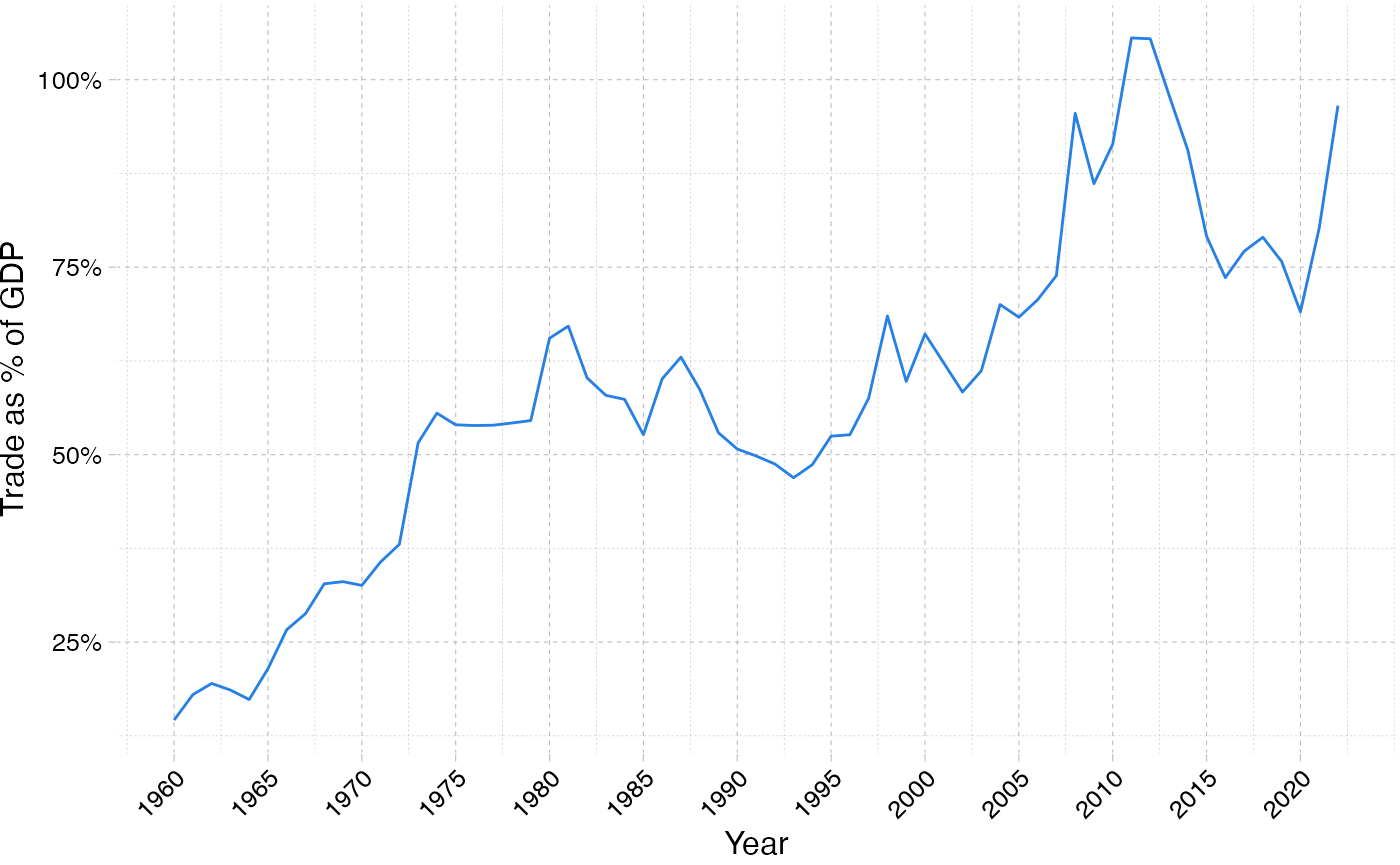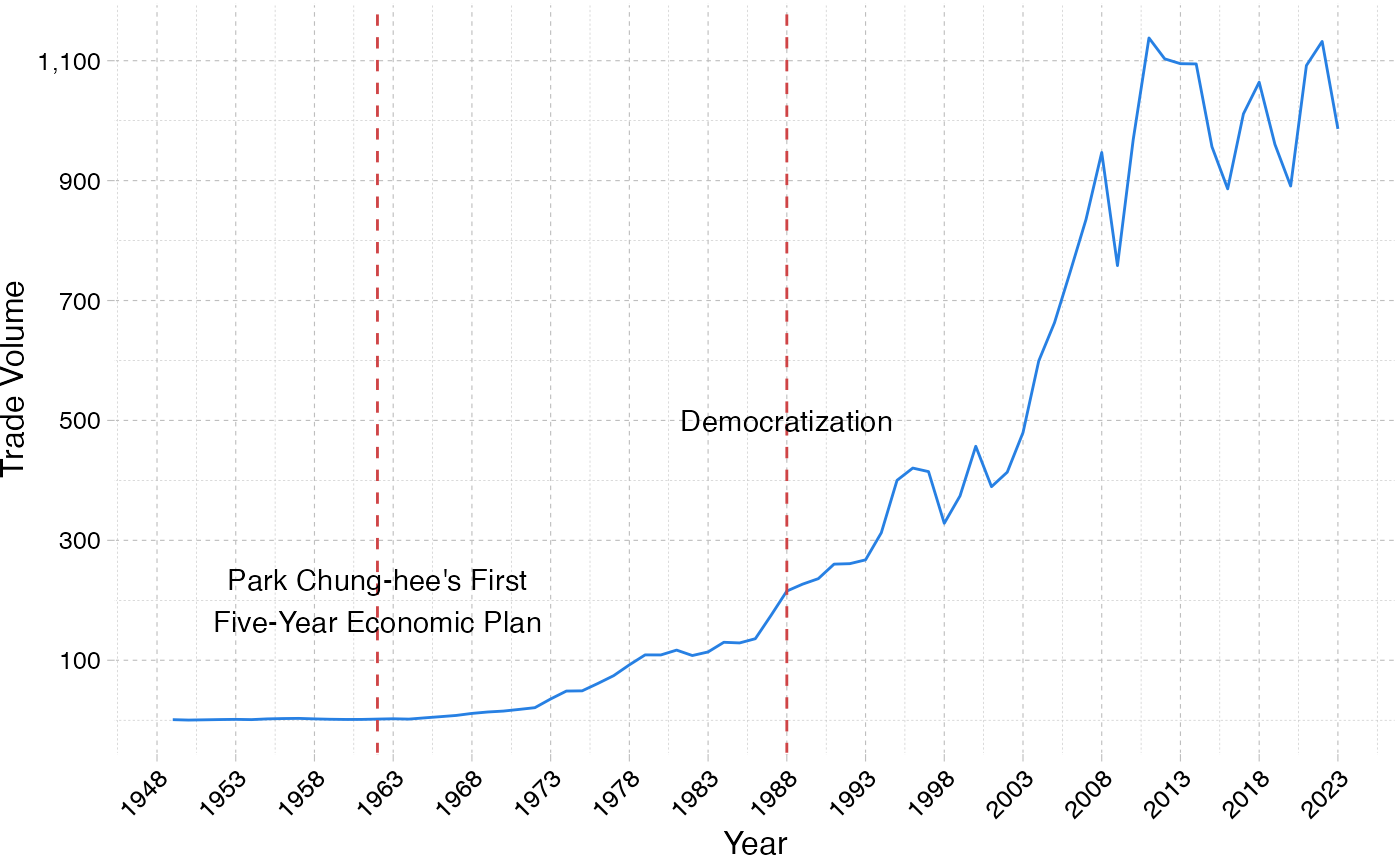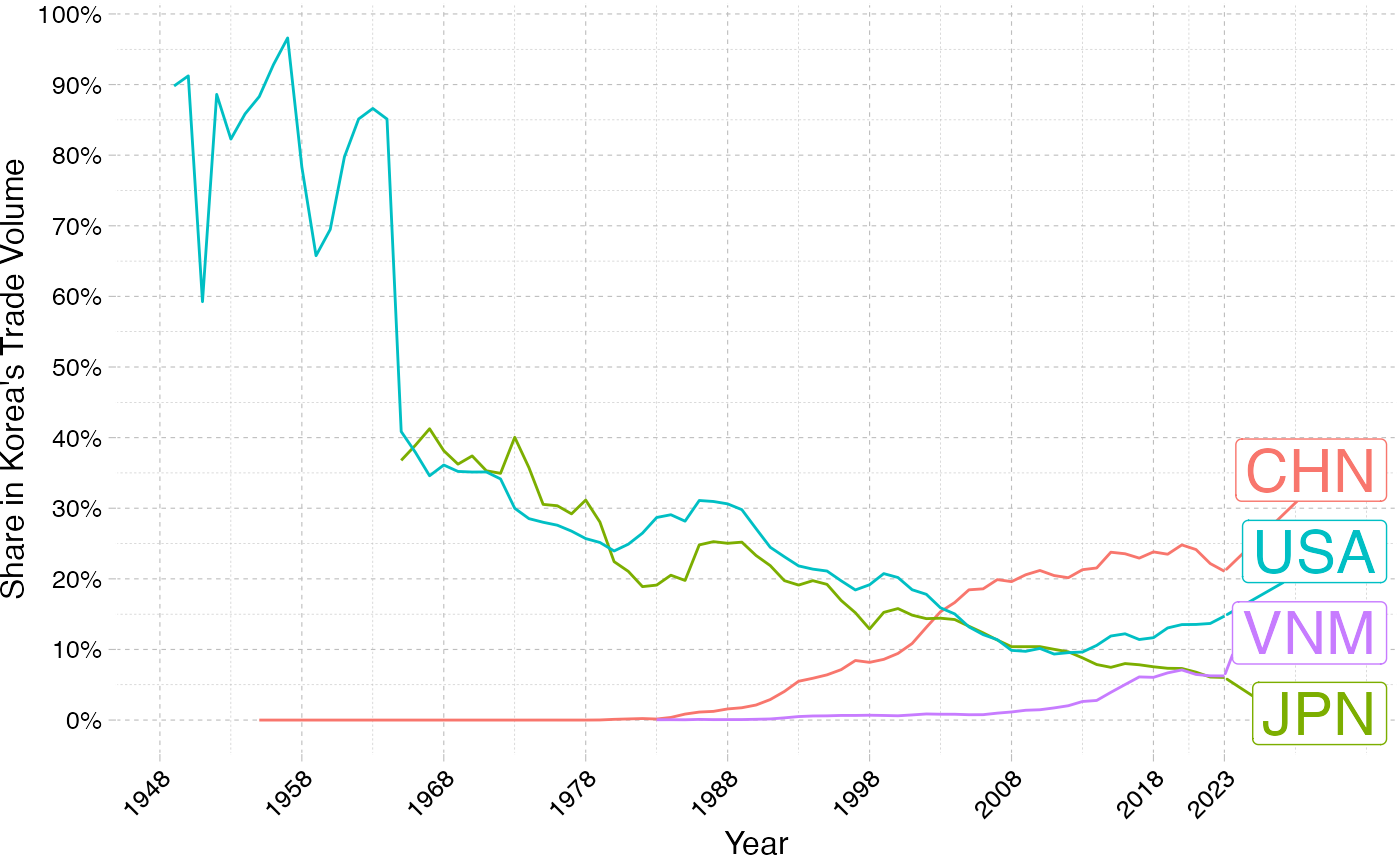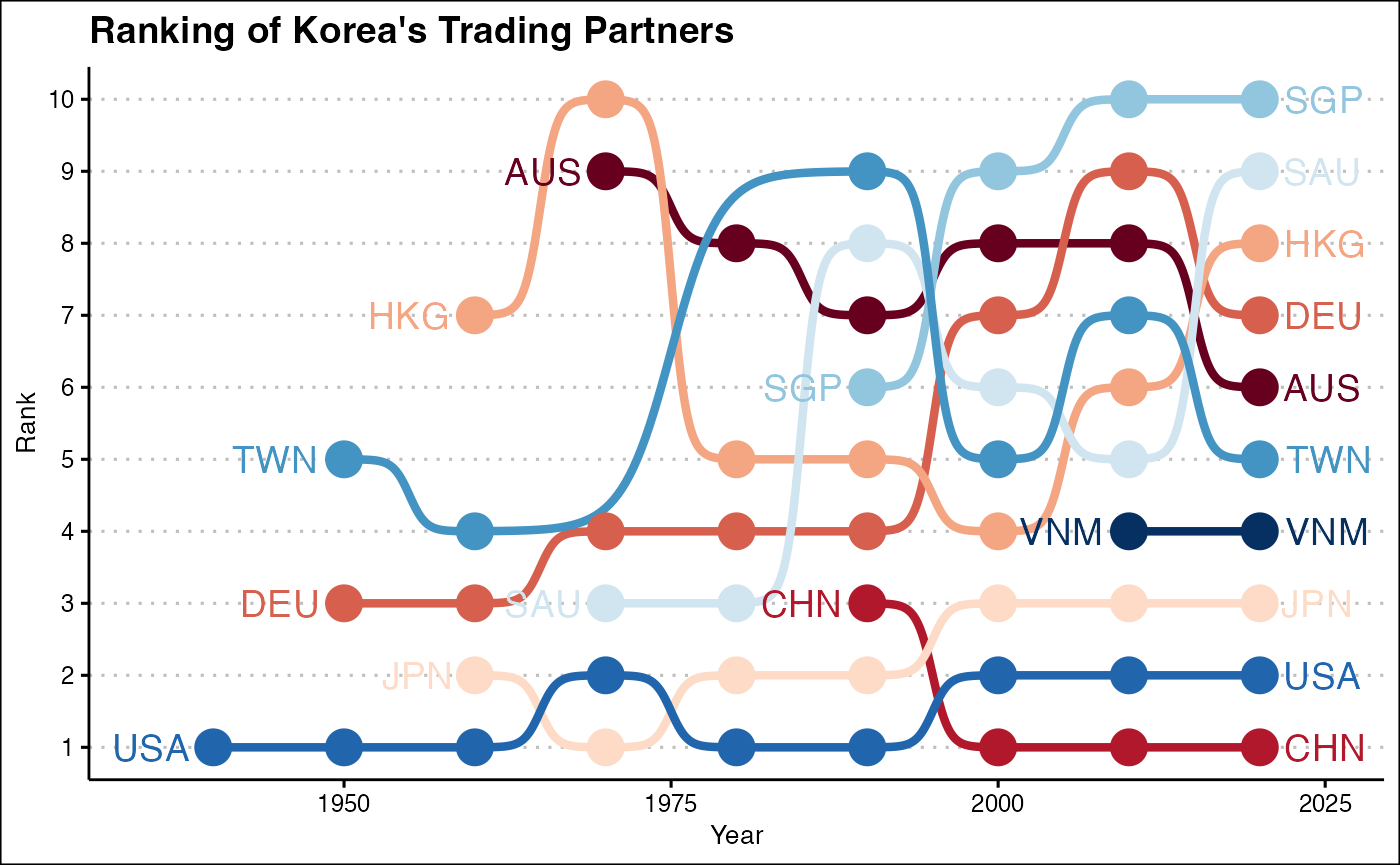Korea's Trade Data Vignette
Kadir Jun Ayhan
2024-04-24
Source:vignettes/trade_data-vignette.Rmd
trade_data-vignette.RmdSince the foundation of the Republic of Korea in 1948, the economy has been one of the two pillars of Korean diplomacy, alongside security.1 Indeed, the country’s trade has virtually always been over 50% of its GDP since 1970s, reaching over 100% in 2010s.

Trade as % of GDP in Korea
Source: WDI
Therefore, Korea’s trade constitute an important data source for
studies on Korean diplomacy. In this blog post, I will explore the trade
data in the kdiplo R
package. There are two main sources for the data.
Korean Statistical Information Service (KOSIS) which has Korea’s trade data from 1965 until 2023 with countries and regions.
Correlates of War (COW)’s Trade Data v4.0 which Korea’s trade data from 1949 until 2014.
In the trade data in the kdiplo
package, I share both sets of data (export_kosis and import_kosis
referring to export and import data from KOSIS; export_cow and
import_cow referring to export and import data from COW) as well as
mutated export and import variables that rely mainly on KOSIS data, but
imputing it with the COW data where the former is missing. While in my
own research, I use other ways to impute the still missing data, in the
kdiplo
package, I don’t do that, leaving it to the users’ discretion.
Let’s explore Korea’s trade data in the kdiplo
package.
I have not yet created a function to get the data from the package, but one can simply get the data and assign it to an object. This is what the dataset looks like:
## Rows: 16,511
## Columns: 18
## $ iso3c <chr> "ABW", "ABW", "ABW", "ABW", "ABW", "ABW", "ABW"…
## $ country <chr> "Aruba", "Aruba", "Aruba", "Aruba", "Aruba", "A…
## $ year <dbl> 1965, 1966, 1967, 1968, 1969, 1970, 1971, 1972,…
## $ export <dbl> NA, NA, NA, NA, NA, NA, NA, NA, NA, NA, NA, NA,…
## $ import <dbl> NA, NA, NA, NA, NA, NA, NA, NA, NA, NA, NA, NA,…
## $ total_export <dbl> 175082000, 250334000, 320229000, 455400000, 622…
## $ total_import <dbl> 463442000, 716441000, 996246000, 1462873000, 18…
## $ export_kosis <dbl> NA, NA, NA, NA, NA, NA, NA, NA, NA, NA, NA, NA,…
## $ import_kosis <dbl> NA, NA, NA, NA, NA, NA, NA, NA, NA, NA, NA, NA,…
## $ export_cow <dbl> NA, NA, NA, NA, NA, NA, NA, NA, NA, NA, NA, NA,…
## $ import_cow <dbl> NA, NA, NA, NA, NA, NA, NA, NA, NA, NA, NA, NA,…
## $ index <dbl> 52.9, 54.4, 56.1, 58.3, 60.9, 63.9, 66.7, 68.7,…
## $ cpi <dbl> 0.1516194, 0.1559186, 0.1607911, 0.1670966, 0.1…
## $ export_cons_2015 <dbl> NA, NA, NA, NA, NA, NA, NA, NA, NA, NA, NA, NA,…
## $ import_cons_2015 <dbl> NA, NA, NA, NA, NA, NA, NA, NA, NA, NA, NA, NA,…
## $ total_export_cons_2015 <dbl> 1154746877, 1605542879, 1991584636, 2725369811,…
## $ total_import_cons_2015 <dbl> 3056614628, 4594968105, 6195904267, 8754655055,…
## $ updated_at <date> 2024-04-27, 2024-04-27, 2024-04-27, 2024-04-27…Trends in Korea’s Trade Volume over Time
Let’s mutate the trade volume as the sum of exports and imports, and the total trade volume as the sum of total exports and total imports.
Let’s visualize the inflation-adjusted trade volume over time.

Korea’s Trade Volume (in billion 2015 Constant USD)
There is this myth that Korea’s economic development was all thanks to Park Chung-hee’s economic development plans which built on export-led industrialization. Although we cannot deny his influence on Korea’s industrialization and economic growth, but Korea’s trade volume has grown exponentially since the 1990s following the country’s liberalization and democratization.

Korea’s GDP Growth Rate
Source: WDI
Trade Dependence
We live at an age of increasing great power rivalry in the Indo-Pacific region, even this relatively new geopolitical naming of the region causing controversies with China. For quite a long time, region’s two great powers, China and Japan, outsourced great power management to the United States and ASEAN. However, in recent years with growing assertiveness of Chinese foreign policy and the US’s pivot to Asia, the region has seen the rise of US-centric minilateralisms that one way or another encircle China. For long, Korea, despite its iron-clad alliance with the US, has not taken an active part in most of these minilateralisms to avoid antagonizing China. Often two reasons are cited for this: 1) Korea’s economic dependence on China, and 2) China’s influence on North Korea, hence Korean Peninsula.
Let’s visualize Korea’s trade dependence over time.

Korea’s Trade Dependence with China, US, Japan, and Vietnam
China has surpassed Japan and the United States as Korea’s largest trading partner since the mid-2000s. Before COVID-19, China’s share in Korea’s trade reached 25%, declining since then to just above 20%, but still remaining as the largest trading partner. The US’s share in Korea’s trade is around 15%, while Japan and Vietnam’s share has been 6% each. The following is the ranking of Korea’s trading partners since its foundation. Below, I visualize the rankings of Korea’s trading partners over time.

Ranking of Korea’s Trading Partners: 1940s to 2020s
Concluding Remarks
Korea’s trade data is an important source for studies on Korean
diplomacy, helping us understand trends and tendencies in Korean foreign
policy. In this blog post, I explored the trade data in the kdiplo R
package. I visualized the trade volume over time, Korea’s trade
dependence, and the rankings of Korea’s trading partners over time. The
data is available in the kdiplo
package. In the next blog post, I will explore Korea’s economic
diplomacy bringing together the trade data with my other data on Korean
presidents’ bilateral diplomatic visits. Feel free to add comments next
to this blog post, or make requests using the issues tab in the kdiplo
package’s Github.
In line with my post here, I
invite you to explore and interact with this data. Let’s craft stories
together using these datasets and connect through hashtags #kdiplo,
#kdiploviz,
#kdata,
and #kdataviz.